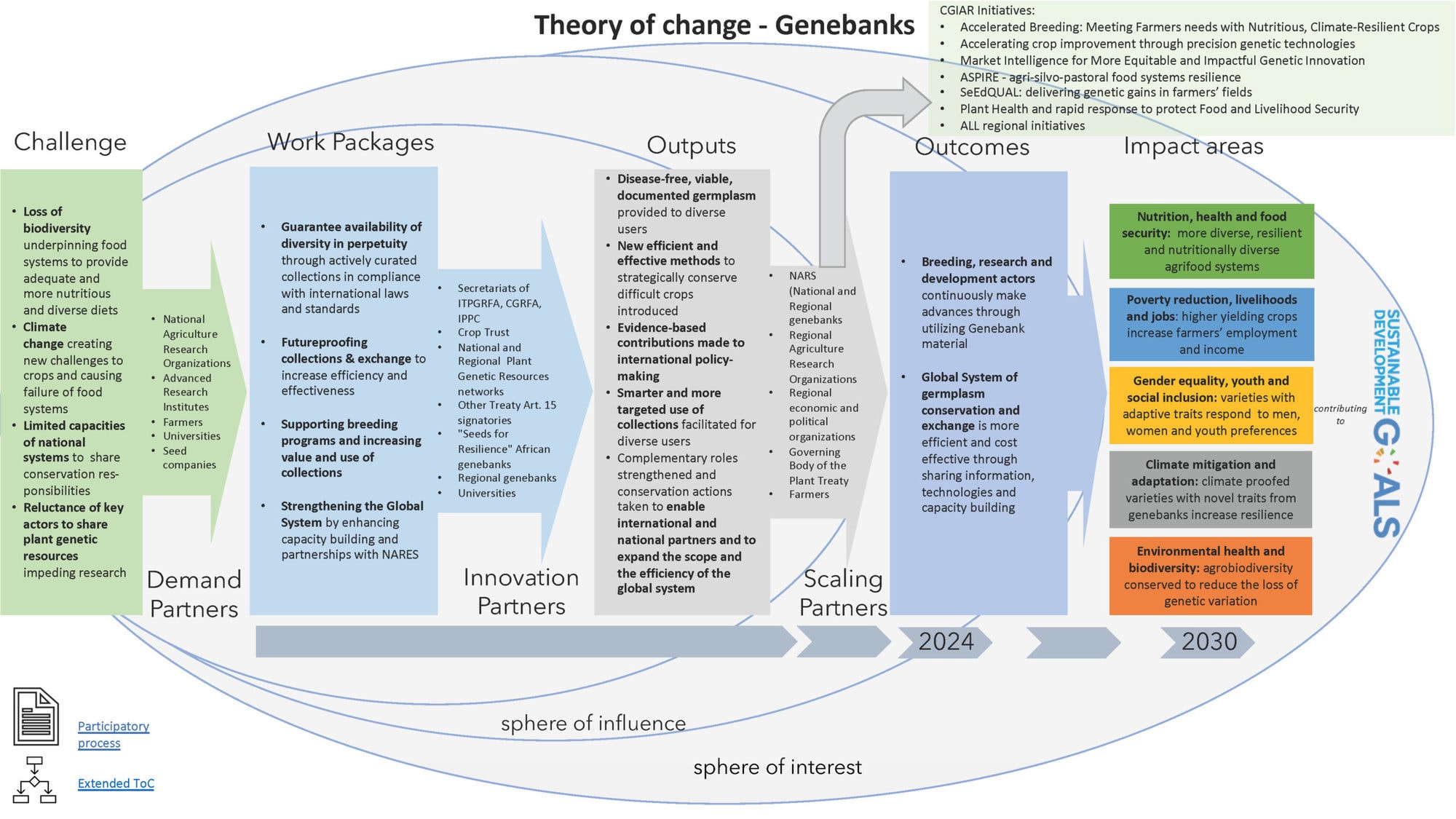Co-creating a Theory of Change for the Genebank Initiative
- From
-
Published on
03.05.21
- Impact Area

A new online process that enabled the Initiative Design Team (IDT) with a large group of genebank managers collaboratively to co-create a complex document at a distance.
The reorganization building towards the new One CGIAR is based on several initiatives that address specific impact areas. In April IDTs were given two weeks to prepare a Pre-concept note and a linked theory of change (ToC). One of those is the Genebank Initiative, which aims to implement technological advances and institutional measures to continue and improve the vital work of conserving important genetic resources for food and agriculture. As with any large program, this ought to engage key stakeholders working together to elaborate a ToC. However, the inability to travel made it essential to consider new tools and approaches to working together. Members of the Management Unit of the CGIAR Research Program on Roots, Tubers and Bananas (RTB), who supported the IDT in developing the ToC proposed experimenting with an online digital whiteboard called Miro.
Theory of Change
A Theory of Change represents a model of how we expect change to take place along an impact pathway. It allows researchers to envisage how an intervention, which might be an entire program or a project within that program, will set in motion a chain of results that in the end is expected to have specific impacts on communities and institutions. Because the ToC forces us to ask how the change will be brought about, it also prompts us to think about who needs to do what to make change happen. As a result, it also helps to set up monitoring and evaluation, by mapping the expected effects and consequences of the intervention. For it to succeed, however, the ToC needs to be carefully considered in all its casual linkages, with those involved in the effort collaborating closely to create the ToC.
Participatory
The goal of the facilitated process was to enable a lively discussion that would allow all participants to contribute to the ToC. The process was simple enough, in outline. A series of brainstorming meetings with the IDT allowed us to define the expected outputs and outcomes, which were used to prepare a draft ToC. This then went back to the CGIAR Genebank managers as key stakeholders to validate and iterate upon.
Our online discussions were made a lot easier by the use of Miro, a digital whiteboard that participants found intuitive and easy to use. It allowed all participants to work on the draft ToC together in real-time, and tracked all edits and changes, making it easy for the group to see areas that needed more detail or improved wording.
Mariana Yazbek (ICARDA), the co-leader of the IDT for Genebanks, recognized the importance of participatory approaches early on and sought to center the newest CGIAR initiative on genetic conservation around an ethos of collaboration. She found that in previous projects it was difficult to “account for decisions made in the planning process, particularly as projects grew in size, scale, and participants”. Being able to track the effectiveness of certain changes using the ToC appealed to Yazbek, which could allow future initiatives to manage variables and workflow with efficiency and ease.
Charlotte Lusty, manager of the current CGIAR Genebank Platform at the Global Crop Diversity Trust and a member of the IDT, particularly valued the ability of the online tool to “foster dialogue between individuals coming from different organizations, with different institutional expertise”. It created an atmosphere of collegiality, with each comment giving way to responses and replies, with criticism taking on a constructive character. There was a real sense of equality and proactivity.
“The ease of the process increased the confidence of participants,” said Enrico Bonaiuti, RTB MEL Program Officer, who aided in facilitation. “That confirmed the value of using an online solution.”
If anything, the tool might have been too easy to use, because the group sometimes ended up with too many sticky notes and cryptic comments, often unsigned. Although a lot was accomplished in one hour, slightly more time would have helped. For a smooth experience, it needs a small team dedicated to regular maintenance, keeping the entire digital whiteboard in good condition.
Overall, the process worked well and resulted in a ToC that forms a strong foundation for the Genebank Initiative, which doubtless will undergo further revision. The digital whiteboard proved its worth and will surely find other uses in building One CGIAR.
RTB supported several other initiatives in the genetic innovation action area and it is committed to the transition toward One CGIAR and support further IDTs during the process of preparing the full proposals.
Related news
-

Agrobiodiversity for People and Planet: How Multifunctional Landscapes Safeguard Diversity, Resilience, and Livelihoods
Multifunctional Landscapes Science Program30.05.25-
Biodiversity
-
Climate adaptation & mitigation
-
Environmental health & biodiversity
-
Food security
-
Health
-
Nutrition
Agriculture and food systems have significantly affected over 75% of Earth's land surface, polluted …
Read more -
-

Protecting biodiversity and securing our future: How IRRI champions diversity in rice systems
International Rice Research Institute (IRRI)22.05.25-
Biodiversity
By Bushra Humaira As the world faces increasing climate challenges, biodiversity is emerging as one…
Read more -
-

Diversifying Cropping for Sustainable Farming: Challenges and Opportunities in Bangladesh
International Rice Research Institute (IRRI)24.04.25-
Biodiversity
-
Food security
Sharif Ahmed and Humnath Bhandari Agriculture in Bangladesh is predominantly focused on rice, with a…
Read more -
